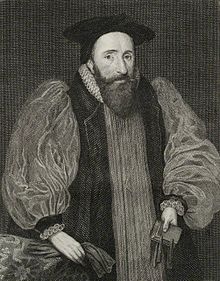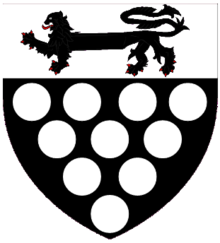John Bridgeman (2 November 1577 – 11 November 1652)[1] was an English Anglican clergyman.
John Bridgeman | |
|---|---|
| Bishop of Chester | |
 | |
| Diocese | Diocese of Chester |
| In office | 1619–1646 (abolition of episcopacy) |
| Predecessor | Thomas Morton |
| Successor | Brian Walton |
| Personal details | |
| Born | 2 November 1577 |
| Died | 11 November 1652 (aged 75) Morton, Shropshire |
| Buried | Kinnerley, Shropshire |
| Nationality | British |
| Denomination | Anglican |
| Spouse | Elizabeth Helyar (m.1606) |
| Alma mater | Magdalene College, Cambridge |
Born in Exeter, he was the eldest son of Thomas Bridgeman and grandson of Edward Bridgeman.[1] He was educated at Magdalene College, Cambridge, where he graduated with a Master of Arts,[2] and then at the University of Oxford, receiving there a Doctor of Divinity.[3] Bridgeman became rector of Wigan in 1615 and also of Bangor in 1621.[3] Two years before, he had been consecrated Bishop of Chester, a post he held until the abolition of episcopacy in 1646.[4] In 1633 Bridgeman was subject to a royal commission of enquiry led by Thomas Canon following complaints to the privy council that Bridgeman had embezzled fines taken for commuting penances.[5] During his tenure, he initialised suspensions against the puritans Thomas Paget, John Angier and Samuel Eaton.[6] He was deprived of his See by Parliament on 9 October 1646, as episcopacy was abolished for the duration of the Commonwealth and the Protectorate.[7][8]
On 29 April 1606, he married Elizabeth Helyar, daughter of Reverend William Helyar,[9] and had by her five sons.[3] Bridgeman died at Moreton, Shropshire and was buried at Kinnerley.[1] His oldest son Orlando was a judge and baronet[10] and his third son Henry Bridgeman a bishop.[3]

References
edit- ^ a b c . Dictionary of National Biography. London: Smith, Elder & Co. 1885–1900.
- ^ "Bridgeman, John (BRGN593J)". A Cambridge Alumni Database. University of Cambridge.
- ^ a b c d Collins, Arthur (1812). Sir Egerton Brydges (ed.). Collin's Peerage of England. Vol. I. London: T. Bensley. pp. 367–369.
- ^ Haydn, Joseph (1851). The Book of Dignities: Containing Rolls of the Official Personages of the British Empire. London: Longman, Brown, Green and Longman's. pp. 377.
- ^ Papers for Sir Thomas Canon’s enquiry of 1633; Staffordshire Record Office D1287/18/2
- ^ Summers, Montague (2003). Geography of Witchcraft. Kessinger Publishing. p. 350. ISBN 0-7661-4536-0.
- ^ Plant, David (2002). "Episcopalians". BCW Project. Retrieved 25 April 2021.
- ^ King, Peter (July 1968). "The Episcopate during the Civil Wars, 1642–1649". The English Historical Review. 83 (328). Oxford University Press: 523–537. doi:10.1093/ehr/lxxxiii.cccxxviii.523. JSTOR 564164.
- ^ "ThePeerage". Retrieved 29 November 2006.
- ^ Debrett, John (1828). Debrett's Peerage of the United Kingdom of Great Britain and Ireland. Vol. I (17th ed.). London: G. Woodfall. p. 239.
- ^ "The Armorial Bearings of the Bishops of Chester". Cheshire Heraldry Society. Retrieved 9 February 2021.